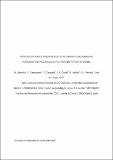Por favor, use este identificador para citar o enlazar a este item:
http://hdl.handle.net/10261/103295COMPARTIR / EXPORTAR:
 SHARE SHARE
 CORE
BASE CORE
BASE
|
|
| Visualizar otros formatos: MARC | Dublin Core | RDF | ORE | MODS | METS | DIDL | DATACITE | |

| Título: | Integrated multienzyme electrochemical biosensors for monitoring malolactic fermentation in wines |
Autor: | Gamella, María; Campuzano, Susana CSIC ORCID; Conzuelo, F.; Curiel, José Antonio CSIC ORCID ; Muñoz, Rosario CSIC ORCID ; Reviejo, A. J.; Pingarrón, José Manuel | Palabras clave: | Enzyme biosensors Malolactic fermentation Self-assembled monolayers |
Fecha de publicación: | 15-may-2010 | Editor: | Elsevier | Citación: | Talanta 81(3): 925-933 (2010) | Resumen: | Integrated amperometric biosensors for the determination of l-malic and l-lactic acids were developed by coimmobilization of the enzymes l-malate dehydrogenase (MDH) and diaphorase (DP), or l-lactate oxidase (LOX) and horseradish peroxidase (HRP), respectively, together with the redox mediator tetrathiafulvalene (TTF), on a 3-mercaptopropionic acid (MPA) self-assembled monolayer (SAM)-modified gold electrode by using a dialysis membrane. The electrochemical oxidation of TTF at +100 mV (vs. Ag/AgCl), and the reduction of TTF+ at -50 mV were used for the monitoring of the enzyme reactions involved in l-malic and l-lactic acid determinations, respectively. Experimental variables concerning the biosensors composition and the detection conditions were optimized for each biosensor. Good relative standard deviation values were obtained in both cases for the measurements carried out with the same biosensor, with no need of cleaning or pretreatment of the bioelectrodes surface, and with different biosensors constructed in the same manner. After 7 days of continuous use, the MDH/DP biosensor still exhibited 90% of the original sensitivity, while the LOX/HRP biosensor yielded a 91% of the original response after 5 days. Calibration graphs for l-malic and l-lactic were obtained with linear ranges of 5.2 × 10-7 to 2.0 × 10-5 and 4.2 × 10-7 to 2.0 × 10-5 M, respectively. The calculated detection limits were 5.2 × 10-7 and 4.2 × 10-7 M, respectively. The biosensors exhibited a high selectivity with no significant interferences. They were applied to monitor malolactic fermentation (MLF) induced by inoculation of Lactobacillus plantarum CECT 748T into a synthetic wine. Samples collected during MLF were assayed for l-malic and l-lactic acids, and the results obtained with the biosensors exhibited a very good correlation when plotted against those obtained by using commercial enzymatic kits. © 2010 Elsevier B.V. All rights reserved. | Versión del editor: | http://dx.doi.org/10.1016/j.talanta.2010.01.038 | URI: | http://hdl.handle.net/10261/103295 | DOI: | 10.1016/j.talanta.2010.01.038 | Identificadores: | issn: 0039-9140 |
| Aparece en las colecciones: | (IF) Artículos |
Ficheros en este ítem:
| Fichero | Descripción | Tamaño | Formato | |
|---|---|---|---|---|
| monitoring_malolactic_Gamella.pdf | 326,11 kB | Adobe PDF |  Visualizar/Abrir |
CORE Recommender
SCOPUSTM
Citations
48
checked on 19-abr-2024
WEB OF SCIENCETM
Citations
44
checked on 28-feb-2024
Page view(s)
357
checked on 20-abr-2024
Download(s)
526
checked on 20-abr-2024
Google ScholarTM
Check
Altmetric
Altmetric
NOTA: Los ítems de Digital.CSIC están protegidos por copyright, con todos los derechos reservados, a menos que se indique lo contrario.
